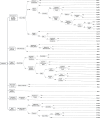The interRAI Suite of Mental Health Assessment Instruments: An Integrated System for the Continuum of Care
- PMID: 32076412
- PMCID: PMC6978285
- DOI: 10.3389/fpsyt.2019.00926
The interRAI Suite of Mental Health Assessment Instruments: An Integrated System for the Continuum of Care
Abstract
The lives of persons living with mental illness are affected by psychological, biological, social, economic, and environmental factors over the life course. It is therefore unlikely that simple preventive strategies, clinical treatments, therapeutic interventions, or policy options will succeed as singular solutions for the challenges of mental illness. Persons living with mental illness receive services and supports in multiple settings across the health care continuum that are often fragmented, uncoordinated, and inadequately responsive. Appropriate assessment is an important tool that health systems must deploy to respond to the strengths, preferences, and needs of persons with mental illness. However, standard approaches are often focused on measurement of psychiatric symptoms without taking a broader perspective to address issues like growth, development, and aging; physical health and disability; social relationships; economic resources; housing; substance use; involvement with criminal justice; stigma; and recovery. Using conglomerations of instruments to cover more domains is impractical, inconsistent, and incomplete while posing considerable assessment burden. interRAI mental health instruments were developed by a network of over 100 researchers, clinicians, and policy experts from over 35 nations. This includes assessment systems for adults in inpatient psychiatry, community mental health, emergency departments, mobile crisis teams, and long-term care settings, as well as a screening system for police officers. A similar set of instruments is available for child/youth mental health. The instruments form an integrated mental health information system because they share a common assessment language, conceptual basis, clinical emphasis, data collection approach, data elements, and care planning protocols. The key applications of these instruments include care planning, outcome measurement, quality improvement, and resource allocation. The composition of these instruments and psychometric properties are reviewed, and examples related to homeless are used to illustrate the various applications of these assessment systems.
Keywords: care planning; case-mix; homelessness; integration; outcomes; psychometric properties; quality.
Copyright © 2020 Hirdes, van Everdingen, Ferris, Franco-Martin, Fries, Heikkilä, Hirdes, Hoffman, James, Martin, Perlman, Rabinowitz, Stewart and Van Audenhove.
Figures








References
-
- World Health Organization Regional Office for Europe. Mental health : facing the challenges, building solutions: report from the WHO European Ministerial Conference Copenhagen, Denmark: World Health Organization, Regional Office for Europe (2005). xi, 181 pp.
-
- Murrell K. Lean Flow and the Impact of the Long-Stay Patient. In: Big Book of Emergency Department Psychiatry: A Guide to Patient Centered Operational Improvement, CRC Press: Taylor & Francis Group; (2017). vol. 10. 10.1201/b21955-20 - DOI
Publication types
LinkOut - more resources
Full Text Sources

